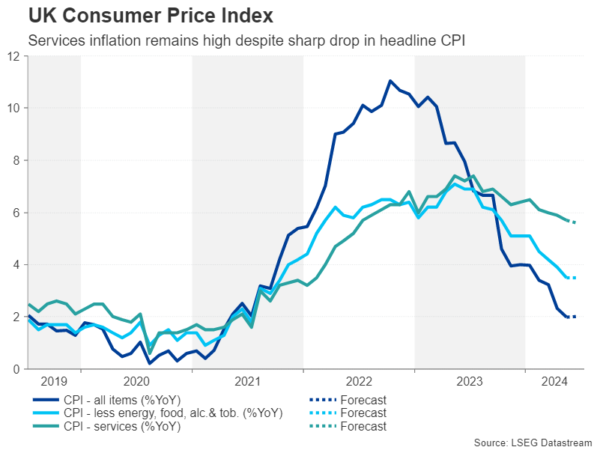- June CPI numbers the highlight of this week’s UK data flurry
- Could the Bank of England cut interest rates next month?
- Pound undeterred as it extends July gains
- Job stats and retail sales to follow Wednesday’s CPI report (06:00 GMT)
On target
Inflation in the UK peaked much higher than in other major economies during the height of the energy crisis in 2022. Logic would therefore dictate that it would take longer to come down, and that is exactly what happened in 2023, to the frustration of Bank of England policymakers. However, 2024 is looking a lot more encouraging for the UK inflation landscape, as the consumer price index (CPI) hit the BoE’s 2.0% target in May, much to the envy of other central banks such as the Fed and ECB, who have yet to achieve their respective targets.
For June, it’s likely to be more of a mixed report. The annual rate of CPI is forecast to hold steady at 2.0%, with the month-on-month rate easing from 0.3% to 0.1%. But core CPI is expected to stay unchanged at 3.5% y/y, while services CPI is projected to moderate only marginally from 5.7% in May to 5.6% y/y in June.
Those two underlying measures haven’t been declining as fast as the BoE would have hoped, particularly services inflation, which has some correlation with wage growth. Just as is the case with the Fed and ECB, BoE policymakers would need to see more convincing signs that both services CPI and wage pressures are subsiding in a sustainable manner.
Wages could hold rate cut key
For that reason, Thursday’s labour market data will be closely watched too. Employment is expected to have risen by 18k in the three months to May, after falling by 140k in the prior three months. The unemployment rate, meanwhile, is forecast to remain unchanged at 4.4%, having slowly edged up from the post-pandemic low of 3.5% in August 2022.
More importantly, average weekly earnings growth is projected to have slowed from 5.9% to 5.7% y/y in the three months to May, and the same reading is also expected for wage growth that excludes bonuses.
Roaring back
Although a slowdown in wage growth would be a positive development in the fight against inflation, the Bank of England is unlikely to drop its caution anytime soon and recent commentary from officials confirms this. Another reason for the BoE not to be in a rush to start cutting rates is that the economy seems to be recovering faster than expected from the shallow recession in the second half of last year. GDP grew by a solid 0.7% q/q in Q1, and second quarter growth could be just as strong.
Friday’s retail sales figures will be a good indication of how consumer spending fared at the end of Q2. After rebounding sharply by 2.9% m/m in May, retail sales likely fell back by 0.4% in June.
Pound surges despite rate cut bets
With the Bank of England’s next policy decision fast approaching on August 1, investors have assigned around a 50% probability of a 25-basis-point rate cut. This isn’t surprising considering that there doesn’t seem to be a consensus within the Monetary Policy Committee, and whatever the outcome of the August meeting, the one certainty is that it the vote will be split.
If the incoming data supports the case for an August rate cut, the pound, which has rallied more than 2.5% in July, will likely retreat from the $1.3000 area. It could potentially slip all the way down to $1.2800, which has been a frequent resistance zone over the past year and could now turn into a support level.
However, if the inflation and wage growth numbers are broadly stronger than anticipated, cable could break above $1.3000 and aim for the July 2023 peak of $1.3144.
A hawkish cut?
On the whole, the BoE has been gradually building the case for a rate cut, so unless there are some big upside surprises in this week’s releases, policymakers will probably take that first step and press the cut button at the upcoming meeting. The only problem is that, with an economy that’s potentially gathering steam again, how much will they be able to cut thereafter?
Either way, it seems that the brighter economic outlook combined with the end of political drama following Labour’s landslide election victory have put a floor under sterling.















